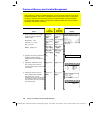
Chapter 20: Number Bases 343
20NUMBAS.DOC TI-89/TI-92 Plus: Number Bases (English) Susan Gullord Revised: 02/23/01 1:17 PM Printed: 02/23/01 2:19 PM Page 343 of 6
Chapter 20:
Number Bases
Preview of Number Bases..................................................................... 344
Entering and Converting Number Bases............................................. 345
Performing Math Operations with Hex or Bin Numbers.................. 346
Comparing or Manipulating Bits.......................................................... 347
Wherever you enter an integer in a
TI
-
89 / TI
-
92 Plus
calculation,
you can enter it in decimal, binary, or hexadecimal form. You can
also set the
Base
mode to specify the form for displaying integer
results. Fractional and floating-point results are always displayed
in decimal form.
Binary numbers use 0 and 1
in the base 2 format:
100
Hexadecimal numbers use
0 – 9 and A – F in the base 16
format:
A8F
You can use the
TI
-
89 / TI
-
92 Plus
to convert a number from one
base to another. For example, 100 binary = 4 decimal and A8F
hex = 2703 decimal.
Hexadecimal numbers are often used as a shorthand notation for
longer, hard-to-remember binary numbers. For example:
1010 1111 0011 0111
The
TI
-
89 / TI
-
92 Plus
also lets you compare or manipulate binary
numbers bit-by-bit.
20
Note: The
MATH
/Base
menu lets you select from a
list of operations related to
number bases.
Dec
Base 10
Bin
Base 2
Hex
Base 16
0
1
2
3
4
5
6
7
8
9
10
11
12
13
14
15
16
0000
0001
0010
0011
0100
0101
0110
0111
1000
1001
1010
1011
1100
1101
1110
1111
10000
0
1
2
3
4
5
6
7
8
9
A
B
C
D
E
F
10
A
2
0
ù
0 = +0
2
1
ù
0 = +0
2
2
ù
1 = +4
16
0
ù
F = +15
16
1
ù
8 = +128
16
2
ù
A = +2560
F37
AF37 hexadecimal is usually easier to work
with than 1010111100110111 binary.


















